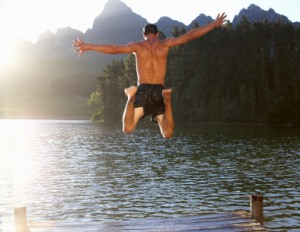I am an “adult onset” swimmer. Learning to swim at age 46, I trembled with the same anxieties as many of my Presentation Skills clients. I even heard myself describe my experience using the same words. Swimming was unnatural, awkward, unnerving, and out of my comfort zone.
Twelve years after my first lesson, I continue to feel amazed at how many parallels I continue to discover between swimming and presenting. I often ask my workshop participants for similarities they perceive between these two divergent activities. Their collective wisdom will help YOU overcome your “fear of the water:”
1. You must prepare
Workshop participants cite this similarity most often. This makes me happy. Open water swimmers can literally die (and sometimes do) for lack of preparation. Presenters can metaphorically “die” if they are not prepared.
Keep the ratio of 1:3 in mind. For each hour spent presenting, it’s wise to put aside a minimum of three hours to design, prepare, and rehearse your material.
2. You must keep focused on the final goal
For swimmers, effectively sighting on the final buoy helps determine who wins and who loses. Open water swimmers can end up swimming hundreds of extra yards if they don’t continually keep their eyes on where they want to end up. Those who sight poorly end up off-course, exhausted, and maybe even wounded: One swimmer I know ran into a piling and broke a tooth because lost sight of his final goal.
Presenters also lose when they drift away from their stated purpose. Remember to carefully craft and state your purpose. (Here’s an article that will help.) Then remain accountable to your purpose throughout your presentation, even if metaphorical winds, chop or waves try to toss you off course.
3. You must stand tall
Efficient, graceful swimmers demonstrate the same physical skills as presenters. Although swimmers remain horizontal, the fastest ones elongate the back of their necks. Their shoulders roll back and down to achieve the most powerful stroke, and their chests press into the water.
Presenters, if you practice these exact physical techniques, you will appear more credible, authoritative, and strong in front of any group.
Both in swimming and presenting, conditions can be rough. The first few strokes can feel icy. But if you’ve taken these three participant-generated tips to heart, you will overcome those challenges within the first few minutes. Then everything will go “swimmingly!”
Send me your “swimming” and “presenting” analogies!


